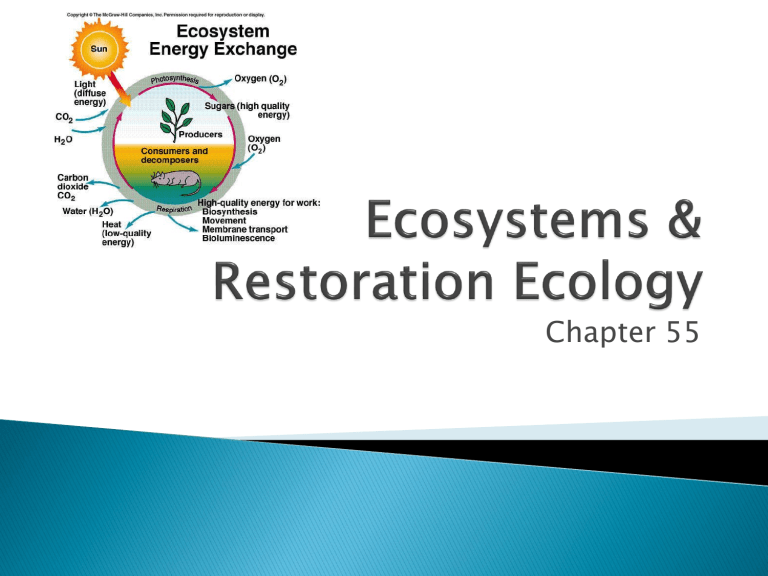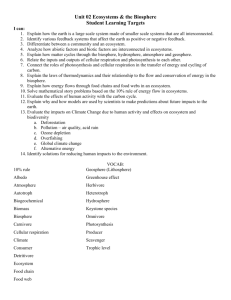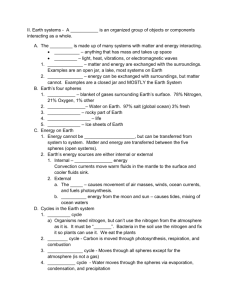Chapter 55 notes

Chapter 55
1.
2.
3.
4.
5.
I can explain how energy regulates the amount and sizes of trophic levels.
1.
2.
3.
4.
5.
I can describe the fundamental relationship between autotrophs, heterotrophs and decomposers in an ecosystem.
I can explain how decomposition connects all trophic levels in an ecosystem.
I can explain why the amount of energy used in photosynthesis is so much less than the amount of solar energy that reaches the Earth.
I can summarize the 10% rule.
I can explain why worldwide agriculture could feed more people if all humans consumed only plant material.
I can explain how limiting factors affect ecosystem dynamics.
1.
2.
3.
4.
I can explain how nitrogen and phosphorous limit the structure of an ecosystem.
I can explain how cultural eutrophication can alter freshwater ecosystems.
I can explain how it is that eutrophic bodies of water are both nutrient rich and oxygen poor.
I can use my understanding of photosynthesis to explain how light limits ecosystems.
I can explain how primary productivity impacts the ecosystem structure.
I can describe how to calculate gross and net productivity.
1.
2.
3.
4.
I can compare gross to net productivity
I can explain the influence of cellular respiration on net productivity.
I can design a lab that measures gross and net productivity.
I can explain how nutrients cycle through an ecosystem.
1.
I can describe how water, nitrogen, carbon, and phosphorous cycle.
2.
3.
4.
5.
I can identify the reservoirs of nitrogen, phosphorous and carbon.
I can describe how living organisms assimilate and release the different nutrients in each cycle.
I can explain the role of bacteria in the nitrogen cycle.
I can explain how the phosphorous cycle is local.
I can describe the role of photosynthesis, and cellular respiration in the carbon cycle.
Trophic efficiencies:10% rule
◦ Generally, only 10% of energy is transferred between trophic levels
◦ Remaining 90% is lost as heat from metabolism
1.
2.
3.
4.
5.
I can explain how energy regulates the amount and sizes of trophic levels.
1.
2.
3.
4.
5.
I can describe the fundamental relationship between autotrophs, heterotrophs and decomposers in an ecosystem.
I can explain how decomposition connects all trophic levels in an ecosystem.
I can explain why the amount of energy used in photosynthesis is so much less than the amount of solar energy that reaches the Earth.
I can summarize the 10% rule.
I can explain why worldwide agriculture could feed more people if all humans consumed only plant material.
I can explain how limiting factors affect ecosystem dynamics.
1.
2.
3.
4.
I can explain how nitrogen and phosphorous limit the structure of an ecosystem.
I can explain how cultural eutrophication can alter freshwater ecosystems.
I can explain how it is that eutrophic bodies of water are both nutrient rich and oxygen poor.
I can use my understanding of photosynthesis to explain how light limits ecosystems.
I can explain how primary productivity impacts the ecosystem structure.
I can describe how to calculate gross and net productivity.
1.
2.
3.
4.
I can compare gross to net productivity
I can explain the influence of cellular respiration on net productivity.
I can design a lab that measures gross and net productivity.
I can explain how nutrients cycle through an ecosystem.
1.
I can describe how water, nitrogen, carbon, and phosphorous cycle.
2.
3.
4.
5.
I can identify the reservoirs of nitrogen, phosphorous and carbon.
I can describe how living organisms assimilate and release the different nutrients in each cycle.
I can explain the role of bacteria in the nitrogen cycle.
I can explain how the phosphorous cycle is local.
I can describe the role of photosynthesis, and cellular respiration in the carbon cycle.
If there is not enough of a resource available, the organisms in the ecosystem are impacted
◦ Nitrogen, phosphorus deficiencies
◦ Used by plants in photosynthesis
◦ Reduced PS = reduced plants = reduced animals
If there is too much of a resource available, the organisms in the ecosystem are impacted
◦ Eutrophication – addition of sewage, fertilizer run off to aquatic ecosystems
◦ Boom in algae, cyanobacteria = less dissolved oxygen for other organisms (fish) = death of fish
1.
2.
3.
4.
5.
I can explain how energy regulates the amount and sizes of trophic levels.
1.
2.
3.
4.
5.
I can describe the fundamental relationship between autotrophs, heterotrophs and decomposers in an ecosystem.
I can explain how decomposition connects all trophic levels in an ecosystem.
I can explain why the amount of energy used in photosynthesis is so much less than the amount of solar energy that reaches the Earth.
I can summarize the 10% rule.
I can explain why worldwide agriculture could feed more people if all humans consumed only plant material.
I can explain how limiting factors affect ecosystem dynamics.
1.
2.
3.
4.
I can explain how nitrogen and phosphorous limit the structure of an ecosystem.
I can explain how cultural eutrophication can alter freshwater ecosystems.
I can explain how it is that eutrophic bodies of water are both nutrient rich and oxygen poor.
I can use my understanding of photosynthesis to explain how light limits ecosystems.
I can explain how primary productivity impacts the ecosystem structure.
I can describe how to calculate gross and net productivity.
1.
2.
3.
4.
I can compare gross to net productivity
I can explain the influence of cellular respiration on net productivity.
I can design a lab that measures gross and net productivity.
I can explain how nutrients cycle through an ecosystem.
1.
I can describe how water, nitrogen, carbon, and phosphorous cycle.
2.
3.
4.
5.
I can identify the reservoirs of nitrogen, phosphorous and carbon.
I can describe how living organisms assimilate and release the different nutrients in each cycle.
I can explain the role of bacteria in the nitrogen cycle.
I can explain how the phosphorous cycle is local.
I can describe the role of photosynthesis, and cellular respiration in the carbon cycle.
Primary productivity
Gross Primary
Productivity
Net Primary
Productivity
Rate at which plants convert sunlight energy into chemical energy
Rate at which plant produces organic material through photosynthesis
Net gain of dried mass stored in plant after respiration
Net
Production
= gross - respiratory production losses
NPP = GPP - R
1.
2.
3.
4.
5.
I can explain how energy regulates the amount and sizes of trophic levels.
1.
2.
3.
4.
5.
I can describe the fundamental relationship between autotrophs, heterotrophs and decomposers in an ecosystem.
I can explain how decomposition connects all trophic levels in an ecosystem.
I can explain why the amount of energy used in photosynthesis is so much less than the amount of solar energy that reaches the Earth.
I can summarize the 10% rule.
I can explain why worldwide agriculture could feed more people if all humans consumed only plant material.
I can explain how limiting factors affect ecosystem dynamics.
1.
2.
3.
4.
I can explain how nitrogen and phosphorous limit the structure of an ecosystem.
I can explain how cultural eutrophication can alter freshwater ecosystems.
I can explain how it is that eutrophic bodies of water are both nutrient rich and oxygen poor.
I can use my understanding of photosynthesis to explain how light limits ecosystems.
I can explain how primary productivity impacts the ecosystem structure.
I can describe how to calculate gross and net productivity.
1.
2.
3.
4.
I can compare gross to net productivity
I can explain the influence of cellular respiration on net productivity.
I can design a lab that measures gross and net productivity.
I can explain how nutrients cycle through an ecosystem.
1.
I can describe how water, nitrogen, carbon, and phosphorous cycle.
2.
3.
4.
5.
I can identify the reservoirs of nitrogen, phosphorous and carbon.
I can describe how living organisms assimilate and release the different nutrients in each cycle.
I can explain the role of bacteria in the nitrogen cycle.
I can explain how the phosphorous cycle is local.
I can describe the role of photosynthesis, and cellular respiration in the carbon cycle.
Biotic factors are made up of matter
(CHNOPS)
This matter cycles in our biosphere
Water cycle
Carbon cycle
Nitrogen cycle
Phosphorus cycle
Nicely reviewed on pages 1228-1229!
Key processes:
◦ Transpiration
Evaporative loss of water through leaves
◦ Condensation
Water vapor forms clouds
◦ Precipitation
Returns water to land
Key processes:
◦ Photosynthesis
Removes atmospheric
CO
2
◦ Cellular respiration
Returns CO
2 atmosphere to
◦ Burning of fossil fuels
Adds significant CO to atmosphere
2
Key processes:
◦ Nitrogen fixation
Conversion of atmospheric
N
2 to usable forms by bacteria
◦ Ammonification
Decomposes organic nitrogen to NH
4
+
◦ Nitrification
NH
4
+ is converted to NO by nitrifying bacteria
3
-
◦ Denitrification
Anaerobic bacteria convert
NO
3
to N
2
Key processes:
◦ Weathering of rocks
Adds phosphorus to soil
◦ Uptake by producers
◦ Producers eaten by consumers
◦ Decomposers return phosphorus to soil
1.
2.
3.
4.
5.
I can explain how energy regulates the amount and sizes of trophic levels.
1.
2.
3.
4.
5.
I can describe the fundamental relationship between autotrophs, heterotrophs and decomposers in an ecosystem.
I can explain how decomposition connects all trophic levels in an ecosystem.
I can explain why the amount of energy used in photosynthesis is so much less than the amount of solar energy that reaches the Earth.
I can summarize the 10% rule.
I can explain why worldwide agriculture could feed more people if all humans consumed only plant material.
I can explain how limiting factors affect ecosystem dynamics.
1.
2.
3.
4.
I can explain how nitrogen and phosphorous limit the structure of an ecosystem.
I can explain how cultural eutrophication can alter freshwater ecosystems.
I can explain how it is that eutrophic bodies of water are both nutrient rich and oxygen poor.
I can use my understanding of photosynthesis to explain how light limits ecosystems.
I can explain how primary productivity impacts the ecosystem structure.
I can describe how to calculate gross and net productivity.
1.
2.
3.
4.
I can compare gross to net productivity
I can explain the influence of cellular respiration on net productivity.
I can design a lab that measures gross and net productivity.
I can explain how nutrients cycle through an ecosystem.
1.
I can describe how water, nitrogen, carbon, and phosphorous cycle.
2.
3.
4.
5.
I can identify the reservoirs of nitrogen, phosphorous and carbon.
I can describe how living organisms assimilate and release the different nutrients in each cycle.
I can explain the role of bacteria in the nitrogen cycle.
I can explain how the phosphorous cycle is local.
I can describe the role of photosynthesis, and cellular respiration in the carbon cycle.






